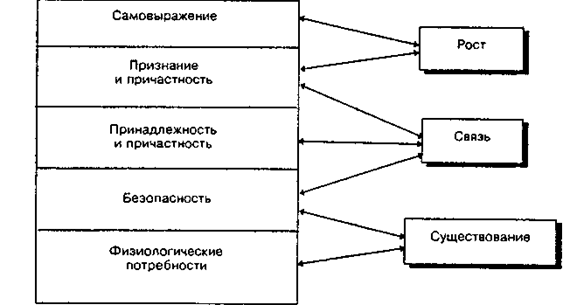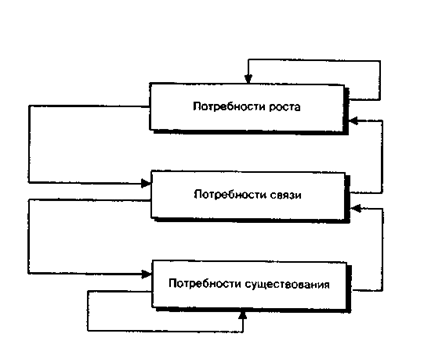home
 Management Management
 Management - Vikhansky OS Management - Vikhansky OS
|
Management - Vikhansky OS
2.2. ERG Theory of Alderfer
Just as Maslow, Clayton Alderfer [3] comes in from his theory that human needs can be combined into a single group. However, in contrast to the theory of Maslow's hierarchy of needs, he believes that the needs of these groups, there are three:
• the existence of needs;
• Communication needs;
• Growth needs.
Groups of this theory needs quite clearly correlated with groups needs Maslow's theory.
The requirements of existence as it includes two groups of Maslow's pyramid of needs: security needs, with the exception of group security and physiological needs. Group communication needs clearly corresponds to the needs of the group affiliation and involvement. The need for communication by Alderfer, reflects the social nature of man, the human desire to be a member of the family, to have colleagues, friends, enemies, bosses and subordinates. Therefore, in this group may also include the recognition of the needs and the self-assertion of the pyramid Mas-Lo, which are associated with the human desire to occupy a certain position in the world, as well as the security needs of the Maslow pyramid, which are associated with the group safety. Growth needs are similar to Maslow's needs pyramid of expression, and also include those needs affirmation and recognition of the group that are associated with the desire to develop confidence, self-improvement, etc (Fig. 2.3).

Fig. 2.3. The ratio of the hierarchy of needs Maslow's theory and the theory of Alderfer
These three groups needs, as well as in the Maslow theory arranged hierarchically. However, between the theories of Maslow and Alderfer, there is one fundamental difference consisting in the fact that, according to Maslow, there is a movement from the need to demand only from below upwards. Meet the needs of low-level, moved to the next, etc. Alderfer believes that the movement goes in both directions. Upstairs, if dissatisfied with the need for low-level, and down, if not met the need of a higher level. Thus Alderfer believes that in case the upper level of dissatisfaction degree enhanced action needs a lower level needs human attention that switches on this level. For example, if a person is not able to meet the needs of growth, he again "turned on" communications needs, and this causes the regression process from the upper level to the lower demand. In accordance with the theory of hierarchy of needs Alderfer reflects the ascension of the more specific needs of a less specific. He said that each time when the need is not met, it switches to a specific need. This process determines whether reverse downwards.
The process of moving up through the levels of needs Alderfer calls the process of meeting the needs, and the process of moving down - the process of frustration, ie defeat in the quest to meet the need.
The presence of the two directions of traffic to meet the needs of additional opportunities to motivate people in the organization. For example, if the organization does not have sufficient capacity to meet the needs of people in growth, then, disappointed, he can switch to the increased interest in the communication need. And in this case, the organization will be able to provide him with opportunities to meet these needs, thereby increasing its potential to motivate this person.
Theory Alderfer, being relatively young, has a fairly small amount of empirical evidence of its correctness. But nevertheless, the knowledge of this theory is useful for management practices, as it opens up perspectives for managers to find effective forms of motivation, correlated with lower levels of need, if you can not create the conditions to meet the needs of a higher level (Fig. 2.4).

Fig. 2.4. Driving ascent and return down the hierarchy of needs Alderfer


Comments
Commenting, keep in mind that the content and the tone of your messages can hurt the feelings of real people, show respect and tolerance to his interlocutors, even if you do not share their opinion, your behavior in terms of freedom of speech and anonymity offered by the Internet, is changing not only virtual, but real world. All comments are hidden from the index, spam control.